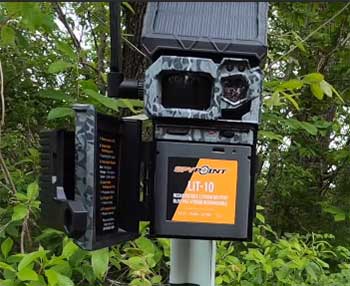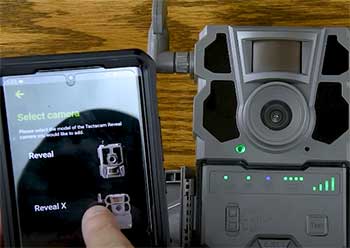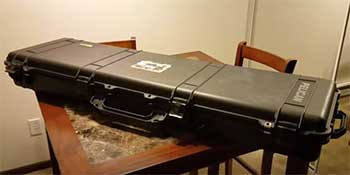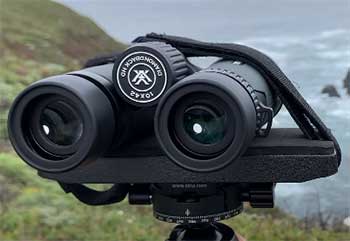SPYPOINT and Tactacam cellular trail cameras are some of the best in the market, and despite their many similarities, their performance sets them apart.
Trail cameras were designed to put eyes up in trees. A great gift of stealth to hunters, these devices have often proven invaluable in their kits. However, they have their limitations.
Rather than sneaking into the forest often, hunters can set up their wireless trail cams and can get pictures sent directly to their phones, conserving time and effort.
A Quick Comparison Table
Before we delve into the detailed comparison between Tactacam and SPYPOINT, let’s check out their primary differences briefly.
| Specifications | SPYPOINT | Tactacam |
| Megapixels (MP) | 10 MP to 30 MP | 16 MP |
| Detection Range | 70 feet to 100 feet | 96 feet |
| Trigger Speed | 0.5 – 0.07 seconds | 0.5 seconds |
| Additional Benefits | IP66 | SPYPOINT app |
Key Differences Between Tactacam And SPYPOINT Trail Camera
- Megapixels (MP)

A million distinct pixels make up each megapixel. The higher the pixel count of a cellular trail cam, the greater detail will be captured in your videos or photos.
However, it is not as simple as selecting the camera with the greatest megapixels.
Manufacturers frequently promote big megapixel sensors in their products just to increase the digits on the packaging.
What’s really important is the sensor’s ability to capture light.
Sensors in cellular game cameras are often not very large, which is a given because they must perch under a tree and try to remain undiscovered.
Thus, even if you own a device with a huge megapixel sensor, the benefit is rendered moot if the sensor cannot get adequate light.
For SPYPOINT, the megapixels on their trail cameras range from 10 MP to 30 MP, with the Force-Pro having the highest resolution specs. On the other hand, both of Tactacam’s trail cameras, the Reveal X Gen 2.0 and Reveal X-Pro offers 16 MP cameras.
Also Read: Differences Between Spartan GoCam And Ghost Cam.
- Detection Range
Measured in feet, the detection range is defined as the distance a sensor can recognize an animal, be it a deer, an elk, or whatever game you are trying to score. It gauges the difference between an animal’s body heat and its surroundings.
Trail cameras equipped with larger detection ranges allow hunters greater visibility once they are set up. However, if you wish to monitor something small, such as a food plot, perhaps consider something smaller.
The lowest detection range of any SPYPOINT trail camera is 70 feet whereas the highest stands at an impressive 110 feet which are for their most high-performing model, the Force Pro.
Tactacam remains consistent with a 96 feet detection range on both their cellular trail cameras.
- Trigger Speed

A trail camera with a rapid trigger is required if you wish to photograph a full animal rather than just one half.
Trigger speed is essentially the time it takes for the gadget to detect movement and click a picture.
One of the most important variables in the cellular trail cam industry is trigger speed.
If you can’t trust your gadget to take a good image of your desired game or land, it’s not worth your effort to hang the device.
Purchase a cam that can snap images in half a second or less. As a result, you will have the best chance of capturing the varieties of deer or elk venturing into your hunting region.
Coincidentally, the fastest trigger speed on any device in today’s market can be found in the SPYPOINT Link-S-Dark Solar. Its 0.07-second trigger second is immensely impressive and will certainly ensure to get snaps of any game in its territory.
Trigger speed on both Tactacam trail cameras is a steady 0.5 seconds, still a good score.
- Warranty
Everyone likes a good warranty. It reaffirms the brand’s faith in the product and also allows you to enjoy the camera knowing if some technical error were to pop up, you would be helped.
All SPYPOINT cameras come with a standard 2-year warranty whereas the standard warranty issue on Tactacam trail cams is a year.
- Price
Cost is definitely the first thing any consumer will consider before making a purchase. Game traps offer state-of-the-art specifications and the newest technology to snap the best photos and videos but are also priced high (generally).
SPYPOINT’s trail cameras range from $90 to $170. Tactacam Reveal X Gen 2.0 is priced at $140 and the Reveal X-Pro costs $170.
- Additional Benefits
A great aspect of the Tactacam cellular trail cameras is their Ingress Protection (IP) rating of IP66. Thanks to this, dust will never get into the camera’s enclosure. Plus, the cameras are made to tolerate low-pressure water jets from every direction.
SPYPOINT impresses with its SPYPOINT app which allows users to configure the camera entirely from their device.
Which Trail Camera Is Better for You?
We find there is no one-size-fits-all answer to this question. While SPYPOINT offers a few affordable models that still perform well, Tactacam takes the cake for better performance all-round.
Consider your budget before making the call. The build quality on Tactacam cellular cameras is hard to beat but the SPYPOINT app seamlessly integrates your device with the cam.
Also Read: Differences Between Benelli Nova And Winchester SXP Shotgun.
Frequently Asked Questions (FAQs)
Bushnell, SPYPOINT, Tactacam, and Stealth Cam make the best trail cameras today.
On average, a trail camera lasts eight to 12 months, taking around 20,000 pictures in between.
If the signal is weak, a Tactacam camera might not send the pictures to your mobile, but rather save them to the internal SD card.
Yes, Verizon is used in some SPYPOINT devices.
Conclusion
That was all on SPYPOINT vs. Tactacam trail cameras. Now that you know the basics of the brands, we are curious to know which camera will finally make the cut for you.
Remember that you do not have to pay for an arm and a leg for these devices. Many of them are quite budget-friendly and get the job done.

